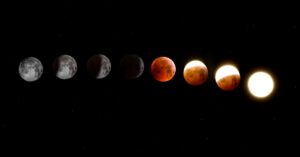This site contains affiliate links to products. I may receive a commission for purchases made through these links.
Stargazing is an exciting hobby that has gained popularity in recent years. Whether you are an experienced astronomer or just starting, choosing the right tool to assist you in your celestial observations is critical.
Two common options for stargazers are telescopes and monoculars.
The telescope is the ideal optical instrument for astronomers viewing deep-sky objects such as nebulae, planets, moons, and galaxies. Monoculars are handheld devices that view far-distant objects with only one eye. However, the monocular has limited use in stargazing due to its smaller aperture size, low magnification, and shorter focal length.
In this blog post, we will discuss key differences between a telescope and a monocular, the benefits of each instrument, and when to choose any based on your intended use. We will also answer a few questions, including if you can observe the planets with a monocular.
Is a monocular more suitable than a telescope?
The choice between a monocular and a telescope will depend on your intended use and experience with stargazing. Monoculars are typically smaller, lighter, and more portable than telescopes, making them a good choice for those who want a lightweight, easy-to-carry tool for observing far-distant objects.
For example, if you love watching birds, hunting, or scouting, a monocular is a much better choice than a telescope. On the other hand, telescopes generally provide a clearer and more detailed view of the night sky.
Monoculars can be designed to have exclusive features, including a built-in compass, zoom power monoculars, rangefinder, and even night vision monoculars.
However, if you are serious about stargazing or astronomy, you might want to go all in and purchase a telescope. A good telescope will give you the best view of celestial objects like planets, stars, and the moon in as much detail as possible.
What are the benefits of using a monocular?
There are many benefits of using a monocular. However, its usefulness will depend on your specific needs and preferences. Here are some benefits of using a monocular:
Portable and lightweight
Monoculars are small and lightweight, making them easy to carry around and use on the go. This makes them ideal for people who love engaging in outdoor activities like hiking, camping, traveling, and stargazing.
Easy to use
Monoculars are typically more user-friendly than telescopes and don’t require any special setup or assembly. They are also easier to focus on and can be used with one hand, making them a fine choice if you want a more straightforward tool.
In addition, some people may find that using a monocular is more comfortable for their eyes, as it only involves the use of one eye. This can be particularly helpful for people with vision problems in one eye or those who find it challenging to use both eyes together.
Lower cost and more affordable
Monoculars are typically less expensive than telescopes, making them a good choice for those new to stargazing or on a budget. They offer an excellent introduction to the hobby without making a significant investment.
When to choose a monocular?
A monocular can be a great choice in several different situations, including:
For casual and recreational stargazing
Monoculars can be a convenient and cost-effective choice for casual and recreational stargazing. They are compact, lightweight, and easy to carry, making them ideal for stargazing on the go.
When choosing a monocular for casual and recreational stargazing, it’s essential to consider the magnification power. A magnification power of 7x to 15x is generally sufficient for casual stargazing, allowing you to see details in the night sky while still being able to hold the monocular steady. Anything smaller is better suited to wildlife spotting.
In addition to magnification power, the objective lens size is also essential. A larger objective lens will gather more light, resulting in a brighter image. For casual stargazing, a monocular with an objective lens size between 40-50mm is recommended.
A top-notch monocular that fits is the Opticron Explorer WA ED-R 8×42. This monocular has 8x magnification power and an objective lens of 42mm, making it a perfect choice for casual stargazing.
The Opticron Explorer WA ED-R 8×42 is also compact and lightweight, which makes it great for beginners to seek out their subjects.

Get the Opticron Explorer WA ED-R 8×42 on Amazon.
For wildlife observation and hunting
Using a telescope for daytime observation, such as watching wildlife, can be tricky. If you’re a nature enthusiast, birdwatcher, or hunter, it is best to choose a monocular for observing wildlife in the field. A monocular gives you the precise target spotting of distant objects. With the right monocular and some practice, you can enjoy private views of the wildlife that surrounds you from a distance without disturbing their natural behavior.
A good monocular you might want to consider is the Hawke Endurance ED 10×42 monocular. This monocular has 10x magnification power and an objective lens of 42mm, making it an excellent choice for wildlife observing, hunting, and stargazing.
The Hawke Endurance ED 10×42 monocular is also waterproof and fog-proof, which is vital for use in various weather conditions.

Get the Hawke Endurance ED 10×42 monocular on Amazon.
For travel and outdoor activities
Compared to a telescope, a monocular can be a versatile and convenient tool to have. Its compact size and lightweight design make it easy to carry in a backpack, pocket, or purse. This enables you to quickly and easily have a closer look at the world around you when traveling, hiking in the mountains, or simply exploring your local park.
For exclusive tips on astronomy, monoculars, and telescopes, subscribe to Telescope Guides newsletter.What are the benefits of using a telescope?
A telescope is an instrument used to view distant objects by gathering and focusing light. It offers many of the same benefits as monoculars, but they also have some unique advantages. With that said, here are some benefits of using a telescope:
Increased magnification and image clarity
Telescopes have a much higher magnification power than monoculars, which enables you to see objects in the sky in much greater detail. Hence, they are ideal for viewing distant stars, galaxies, and celestial objects.
Also, most telescopes feature high-quality optics, such as lenses or mirrors, that can produce a more explicit and sharper image than you would get with a monocular. This makes it easier to see fine details in the night sky, such as the rings of Saturn or the craters on the moon.
An excellent example of such a telescope is the Celestron Inspire 100AZ Refractor. This telescope is designed to be simple and smart for new astronomers of all ages.
It has a maximum magnification of 241x and a lowest useful magnification of 15x. It has an objective lens of 100mm. Its fully coated glass optics deliver stunningly detailed images, perfect for stargazing at your favorite campsite or backyard.

Get the Celestron Inspire 100AZ Refractor telescope on Amazon.
Larger aperture and improved light-gathering ability
Telescopes typically have larger apertures (the diameter of the lens or mirror) than monoculars, which allows them to gather more light from distant objects in the night sky. With its improved light-gathering ability, a telescope can provide a more immersive viewing experience, allowing you to see the night sky in greater detail and with clarity that might not have been visible with a monocular.
A fantastic telescope with a massive aperture is the Sky-Watcher Flextube 300 SynScan Dobsonian. This telescope, nicknamed ‘light bucket,’ has a large aperture of 305 mm, meaning it will gather more than most available telescopes allowing you to resolve the finer details in astronomical objects and see deeper into the universe.
The Sky-Watcher Flextube 300 SynScan Dobsonian telescope is also user-friendly, featuring a GoTo function and a motorized alt-azimuth mount for effortless navigation using the SynScan hand controller. Stargazing has never been easier, with over 40,000 celestial targets in its database.

You can find Sky-Watcher Flextube 300 SynScan Dobsonian telescope on Amazon.
Advanced optics and lens coatings
Telescopes often use high-quality optics, such as lenses or mirrors, designed to produce a distinct and sharper image than what you would get with a monocular. These advanced optics and lens coatings help to reduce glare, enhance image clarity, and improve overall image quality providing a more detailed view of the night sky.
A good example of such high-quality optics is the Celestron X-Cel LX Eyepieces. This eyepiece offers a wide 60-degree apparent field of view, which makes it ideal for observing the moon, planets, and various deep-sky objects.
With its six-element optical set featuring high-transmission coatings for enhanced image clarity and contrast, these eyepieces deliver clear, sharp images. The blackened edges of the optics provide added contrast.
Additionally, with 16mm of eye relief and being parfocal, you can easily switch between eyepieces within the series during observing sessions without needing significant refocusing.

Get the Celestron X-Cel LX Eyepieces on Amazon.
When to choose a telescope?
If you’re looking for the best view of the night sky, a telescope can be a great choice in many different situations, including:
For deep-sky observing
A telescope is a must-have tool for observing distant celestial objects, such as galaxies and nebulae. With its larger aperture and improved light-gathering ability, a telescope can provide stunning views of deep-sky objects that are not visible to the naked eye or with a monocular.
For high magnification and image quality
Unlike monoculars, telescopes can magnify objects significantly, allowing for greater image detail and clarity. A telescope with advanced optics and lens coatings provides crystal clear images of celestial objects and other distant targets that would not have been possible to see using a monocular.
For advanced astronomy and scientific application
A telescope is the best option if you are looking for a tool suitable for advanced astronomy and scientific applications. Unlike monoculars, telescopes offer high power magnification, larger aperture size, and advanced optics needed to observe celestial objects with precision and detail.
These features are essential for advanced astronomical research, such as studying the properties of stars, galaxies, and other celestial bodies.
You may also like: Which Telescope Should I Buy? (Master Guide)
Key differences between telescope and monocular
Telescopes and monoculars are great tools that can magnify distant objects, but they have distinct differences that make them suitable for different types of stargazing. Let’s look at the main differences between telescopes and monoculars:
Magnification and image quality
Telescopes typically have much higher magnification power than monoculars. Hence, you can see objects in the night sky in greater detail with a telescope. However, it’s important to remember that higher magnification does not always equal better image quality. The quality of the image is also affected by the aperture size, lens quality, and other factors.
Aperture and light-gathering ability
The most significant difference between telescopes and monoculars is the aperture size. The aperture is the diameter of the lens or mirror that gathers light and directly affects the amount of light that can be collected. Telescopes typically have larger apertures, allowing them to gather more light, which makes it easier to see faint objects in the night sky.
On the other hand, Monoculars generally have smaller apertures, limiting the amount of light they can gather, making it more difficult to see faint objects.
When buying an instrument for stargazing, it’s essential to consider the aperture size. The larger the aperture, the more light the telescope can gather, and the brighter and clearer the image will be.
For advanced astronomical research, we recommend a telescope with an aperture of at least 8 inches.

Get the Celestron NexStar Evolution 9.25 on Amazon.
A good telescope that fits is the Celestron NexStar Evolution 9.25. It is a standout telescope with its single-fork arm and rechargeable lithium-ion battery that allows for 10 hours of continuous use with the touch of a button.
It has built-in Wi-Fi connectivity, enabling control through the Celestron SkyPortal app for iOS and Android. With its motorized mount, this telescope is ideal for astrophotography and can track objects as they move across the sky.
However, its weight may make it difficult to transport, but this trade-off is worth it for its high-quality and robust design. If you’re a seasoned skywatcher and have the budget, this GoTo telescope is a highly recommended choice for a complete high-definition tour of the universe.
You may also like: Celestron SkyPortal WiFi Module (Setup & Review)
Portability and ease of use
Telescopes are generally larger, require additional equipment, and are more difficult to transport than monoculars. While this can be a drawback for some stargazers, it also allows telescopes to have larger apertures and higher magnification power. On the other hand, monoculars are more compact and portable, making them an excellent option for those who like to stargaze while on the go.
Can a telescope serve as a monocular?
Many telescopes can be used as a monocular by removing one of the eyepieces. This is especially useful for stargazers who want the magnification power of a telescope but the portability and ease of use of a monocular.
However, it’s important to remember that using a telescope as a monocular will limit the amount of light that can be gathered, as the aperture size of the telescope will be halved. This can result in a dimmer image, especially when observing faint objects in the night sky.
Can you observe the planets with a monocular?
You can observe the planets with a monocular. The planets are relatively bright objects in the night sky and can be seen even with a small aperture monocular.
However, the level of detail you will be able to see will depend on several factors, including the magnification power of the monocular, the quality of the lens, and the aperture size. With a high-quality monocular, you should be able to see the craters on the moon, planets such as Jupiter and Mars, comets, and star clusters. If you have a good monocular, you can spot Saturn’s rings, the Galilean moons, galaxies, and nebulae.
However, a telescope with a larger aperture and higher magnification power is typically necessary for more detailed observations.
Takeaway: Grab the best optical instrument for optimal stargazing
It is exciting to note that monoculars and telescopes are excellent tools for observing far-distant objects. The choice between them will depend on your specific needs and preferences.
As mentioned, a monocular is a single-piece optical device and offers some unique benefits, such as portability, affordability, and ease of use. You can enjoy stunning views beyond stargazing, including birdwatching, wildlife observation, and sporting events. This makes them a more versatile tool to have. However, it lacks the features required for detailed deep-space object observation.
If you’re looking for a more immersive stargazing experience with the ability to see faint objects in greater detail, a telescope may be the right choice. But a monocular may be a better choice if you’re looking for a more compact and portable option. Regardless of your choice, getting out there and enjoying the night sky is important!
You may also like:




